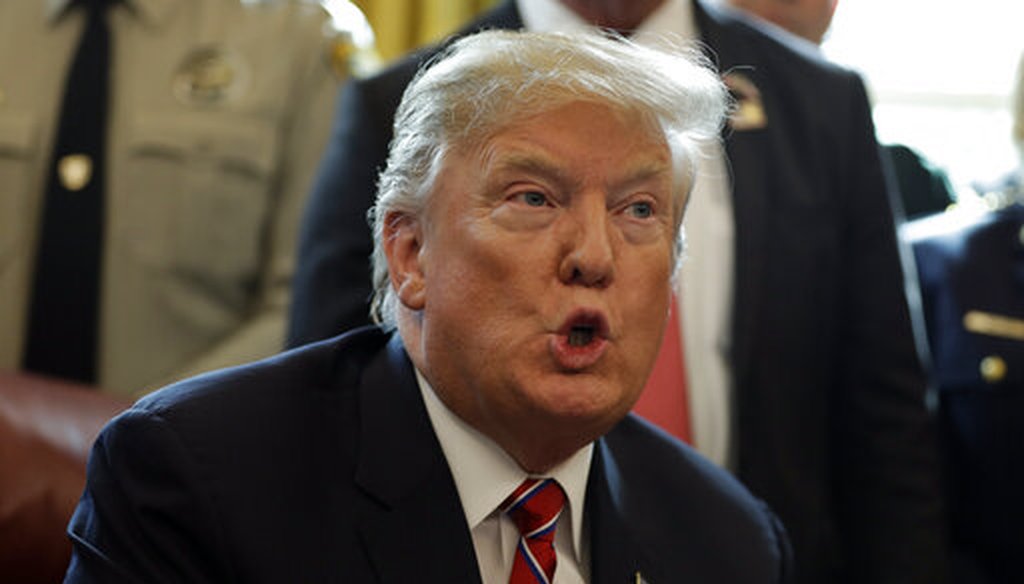Stand up for the facts!
Our only agenda is to publish the truth so you can be an informed participant in democracy.
We need your help.
I would like to contribute

President Donald Trump speaks in the Oval Office of the White House, Friday, March 15, 2019, in Washington. (AP)
It’s becoming a pattern with President Donald Trump: downplaying the seriousness of violence associated with white nationalism.
A reporter asked Trump if he saw a global rise in white nationalism following reports that the Christchurch, New Zealand, shooter was steeped in the ideology.
Trump responded: "I don’t really. I think it’s a small group of people that have very, very serious problems. I guess, if you look at what happened in New Zealand, perhaps that’s a case. I don’t know enough about it yet."
Documenting incidents of white nationalism can be challenging. Nevertheless, data from multiple sources suggest extremist attacks associated with white nationalism and far-right ideology is on the rise.
High-profile incidents in recent years include the mass shootings at a synagogue in Pittsburgh and at a black church in Charleston, as well as pipe bombs sent to prominent Democrats. Trump’s statements about the "fine people" on both sides at the 2017 Charlottesville, Va., march, as well as his travel ban which lists several Muslim-majority nations, have all drawn more attention to reports about extremism.
We sent the White House a summary of reports showing a rise in extremism or white nationalism. Spokesman Hogan Gidley did not counter those reports.
"The President was clear this was a horrible terrorist attack and that it’s a serious problem that such a sick group of people share these dangerous, disgusting views," Gidley said.
The rundown on white nationalism
The key question in determining whether an incident is driven by white nationalism is whether the perpetrator subscribed to the ideology as seen in organizational connections, social media or a personal manifesto.
That isn’t as clear as it sounds. There is no single definition of white nationalism, partly because of debatable overlap among white nationalists, the alt-right, the Ku Klux Klan and neo-Nazis.
Attempts to define these groups prompts more debate. The Southern Poverty Law Center’s growing list of hate groups, for example, has critics who say it maligns some conservative groups that are not extremists. The center says that the number of white nationalist groups surged from 100 to 148 in 2018, noting that the groups have largely retreated from activism following the rally in Charlottesville.
"There is certainly going to be some disagreement over what constitutes white nationalism, and in particular whether a particular attack was motivated by it," said David Sterman, senior policy analyst at New America, which tracks deadly terrorist attacks.
Some research organizations study the category of far-right extremism, which isn’t the same. Far-right groups can be motivated by ideologies seeking an idealized future favoring a particular group. They include religious groups and anti-government militias, among others.
Sterman said an attack on a particular group — for example, Jews — may or may not be a white nationalist attack. For example, jihadists, Palestinian terrorists and Hezbollah have attacked Jews, but they aren't white nationalist groups.
Reports on far-right extremism, hate crimes
The best government resource on hate crimes comes from the FBI. The information comes from about 16,000 participating law enforcement agencies in 2017. It’s important to know this isn’t a comprehensive look at white nationalist attacks, because the government doesn’t code the incidents that way.
But there is something there: The bureau reported a 17 percent increase in hate crimes in 2017 over the previous year, and more than half were motivated by biases based on race, ethnicity or ancestry.
The government doesn’t go much deeper than that. To better understand the attacks, advocacy organizations do their own digging — all with various methodologies and caveats. Some reports look at a broad swath of incidents, such as the Council on American-Islamic Relations’ report of anti-Muslim bias and hate crimes. Other reports focus on deadly attacks.
Three of the most significant studies are from New America, the Center for Strategic Studies, and the Anti-Defamation League. Their analyses, too, show an apparent rise in incidents driven by far-right extremism in recent years.
New America has tracked a rise in deadly attacks by perpetrators with a far-right ideology over the past several years. The think tank’s far-right label includes a combination of people who are either white supremacist or nationalist, anti-government, or exhibit anti-abortion violence.
Overall, these types of deadly attacks do seem to have increased in recent years, Sterman of New America said.
The Center for Strategic and International Studies, an institution focusing on international public policy issues, looked at cases of terrorism between 2007 and 2017 using the Global Terrorism Database at the University of Maryland’s National Consortium for the Study of Terrorism and Responses to Terrorism. It found that right-wing extremism in the United States and Europe appears to be growing.
In the United States between 2007 and 2011, the number of such attacks was five or less per year. The number rose to 14 in 2012, continued at a similar level through 2016, and then jumped to 31 in 2017.
The perpetrators were mostly white supremacist or anti-government "sovereign citizens."
In Europe, meanwhile, the number of far-right attacks rose from zero in 2012 to 30 in 2017.
Several factors have contributed to the rise, including the ability of extremists to use the internet and social media to carry out their agenda. They have also been energized by certain issues, including waves of immigration.
While the report by the Center for Strategic and International Studies states that Trump has energized some right-wing extremists, his election doesn’t fully explain this trend.
"The first notable increase in right-wing terrorist attacks over the past decade occurred in 2012 — from one attack in 2011 to 14 in 2012 — four years before President Trump was elected," the report said.
The Anti-Defamation League’s report tracks murders perpetrated by all types of extremists. That report found that domestic extremists killed at least 50 people in the United States in 2018, the fourth-deadliest year since 1970. The number of deaths was higher than 2017 but lower than 2015 and 2016.
However, the ADL counts murders by extremists whether they were motivated by an ideology or not. For example, the list includes the shooting at Marjory Stoneman Douglas by a perpetrator who had shown signs of racism and anti-Semitism, including the symbols on his backpack, but there is little evidence to conclude the mass shooting was primarily a white supremacist attack.
The ADL includes both types of killings, because it can be difficult to discern to what extent ideology played a role and to show that many of these movements promote violence, said Oren Segal, director of the ADL’s Center on Extremism.
Deadly attacks by extremists only tell part of the story about white nationalism, Segal said. There are other signs, including an apparent rise in white nationalist propaganda and growth in online activity by white supremacists.
"Language that used to be something I would see on a random forum on a random place on the internet now seems to be part of a public discussion," he said.
Our Sources
NBC, Tweet, March 15, 2019
New America, What is the threat to the United States today?
New America, Anti-Muslim activities in the United States, 2019
Center for Strategic and International Studies, The Rise of Far-Right Extremism in the United States, Nov. 2018
National Consortium for the Study of Terrorism and Responses to Terrorism, Ideological Motivations of Terrorism in the United States, 1970--2016
Anti-Defamation League, Murder and extremism in the United States in 2018
Anti-Defamation League, White Supremacists Step Up Off-Campus Propaganda Efforts in 2018
FBI, Hate crime statistics for 2017
Council on American Islamic Relations, Civil rights report, 2018
Southern Poverty Law Center, Hate groups reach record high, Feb. 19, 2019
Washington Post, Congress pushes the FBI for domestic terror data amid rise in right-wing extremism, March 15, 2019
Washington Post, Trump says white nationalism is not a rising threat after New Zealand attacks: ‘It’s a small group of people,’ March 15, 2019
AP, White House aide says 'absurd' to link shooter and Trump; But defense fails to silence critics, March 18, 2019
TIME, Trump Says He Doesn't See White Nationalism as a Rising Global Threat After New Zealand Shooting, March 15, 2019
PolitiFact, A look at the data on domestic terrorism and who’s behind it, Aug. 16, 2017
PolitiFact, Fact-checking Cory Booker's statistic on attacks by white nationalist hate groups, Jan. 18, 2018
PolitiFact, Are there white nationalists in the White House? Aug. 15, 2017
PolitiFact, Is the Center for Immigration Studies a hate group, as the Southern Poverty Law Center says? March 22, 2017
Interview, David Sterman, New America policy analyst, March 19, 2019
Interview, Robert McKenzie, New America senior fellow, March 20, 2019
Interview, Jeff Giertz, U.S. Sen. Cory Booker campaign spokesman, March 18, 2019
Interview, Oren Segal, director of the ADL’s Center on Extremism, March 19, 2019
Interview, Hogan Gidley, White House spokesman, March 19, 2019












































